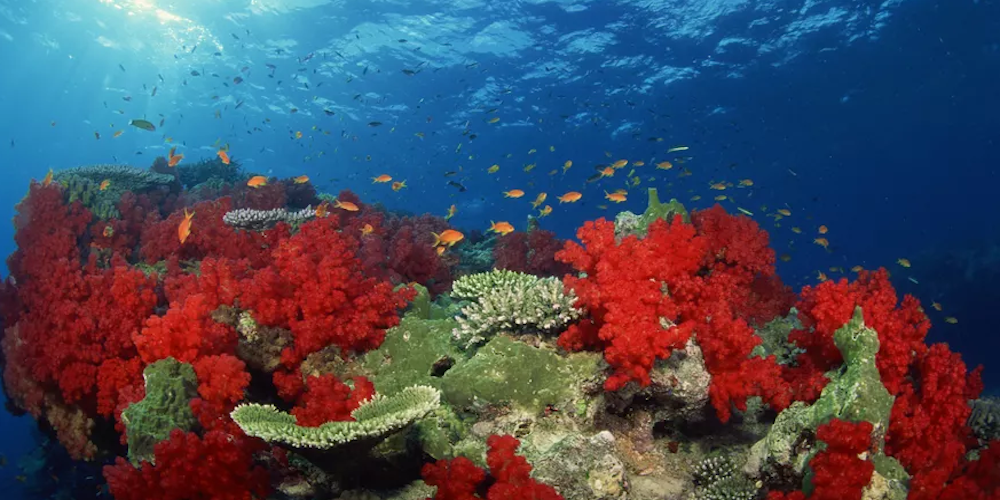Protecting the Ecosystem

The Government of India has been undertaking number of steps aimed at protecting the ecosystem and implementing conservation which have a direct/indirect impact on combating climate change
India has updated its Nationally Determined Contribution (NDC) in 2022 and enhanced its target of electric power generation installed through non-fossil fuel to 50% by 2030 and to reduce the emission intensity of the GDP by 45% as compared to 2005 levels and has set a target for creation of carbon sink of 2.5 – 3 billion tons by 2030, according to Union Minister of State for Environment, Forest and Climate Change, Shri Ashwini Kumar Choubey.
The Government of India has also included a non quantitative target in the updated NDC namely LiFE – ‘Lifestyle for Environment’ as a key to combating climate change by involving people’s everyday actions. Besides, India has also submitted its Long Term Low Emission Development Strategy (LT-LEDS) in COP 27 which has declared its goal of becoming net-zero by 2070.
The Government of India is also implementing the National Action Plan on Climate Change (NAPCC) which comprises missions in specific areas of solar energy, energy efficiency, water, agriculture, Himalayan eco-system, sustainable habitat, green India, human health and strategic knowledge on climate change. These Missions are institutionalized and implemented by their respective nodal Ministries. Most of these Missions, inter-alia, focus on adaptation to combat the adverse impacts of climate change.
The National Mission for a Green India (GIM) is one of the eight Missions outlined under the NAPCC. It aims at protecting, restoring and enhancing India’s forest cover and responding to Climate Change by undertaking plantation activities in the forest and non-forest areas.
The Department of Science and Technology is implementing two National Mission – National Mission for Sustaining the Himalayan Ecosystem (NMSHE) and National Mission on Strategic knowledge for Climate Change (NMSKCC).
Under these Missions’ support is being provided to various Institutions and Universities to carry out R&D studies related to climate change science and adaptation strategies.
In order to address the problem of climate change, various mitigation and adaptation strategies have been suitably incorporated under several flagship Urban Missions/ Schemes of the Ministry of Housing and Urban Affairs (MoHUA) viz. Swachh Bharat Mission – Urban (SBM-U), Atal Mission for Rejuvenation and Urban Transformation (AMRUT), Smart Cities Mission (SCM), Pradhan Mantri Awas Yojana – Urban (PMAY-U) and Metro Rail Projects.

The Government has announced the scheme Amrit Dharohar to encourage optimal use of wetlands, and enhance bio-diversity, carbon stock, eco-tourism opportunities and income generation for local communities. Mangrove Initiative for Shoreline Habitats & Tangible Incomes (MISHTI) is being undertaken through NCM for protection of the shoreline and as a climate mitigation and adaptation measure.
DST has also supported 29 States/Union Territories to strengthen State Climate Change Cells (SCCCs) to take up vulnerability & risk assessment and State’s specific issues relating to climate change which outline sector specific and cross sectoral priority actions under State Action Plan on Climate Change (SAPCC).
Government of India has also launched the Namami Gange Programme in 2014-15, to accomplish the twin objectives of effective abatement of pollution, conservation and rejuvenation of National River Ganga and its tributaries. The main objective of the river rejuvenation programme is to meet the primary water quality criteria for outdoor bathing notified by the Ministry of Environment, Forest & Climate Change (MoEF&CC).
Ministry of Environment, Forest & Climate Change has launched National Clean Air Programme (NCAP) in January 2019 to tackle the problem of air pollution in a comprehensive manner with targets to achieve 20 to 30 per cent reduction in PM10 and PM2.5 concentrations by 2024. City Specific Clean Air Action Plans have been prepared and rolled out for implementation in132 non-attainment and million plus cities.
Government of India has launched several schemes / programmes which contribute to the target of restoration of 26 million hectares of degraded land and achievement of land degradation neutrality with focus on sustainable and optimum utilization of land resources. This will help in preserving forests and biodiversity, facilitating conservation of natural resources and improving carbon sinks.
In addition, the Government of India has taken several initiatives for protection of Biodiversity and Conservation through various schemes like National Action Plan for Climate Change (NAPCC); National Mission on Sustainable Habitat; National Water Mission; National Mission for Sustaining Himalayan Ecosystem; Green India Mission; National Mission for Sustainable Agriculture, National Plan for conservation of Aquatic Ecosystems (NPCA); Biosphere Reserve; Watershed Development Project in Shifting Cultivation Areas; Water Resources programme for Repair, Renovation & Restoration of Water bodies; Compensatory Afforestation Fund Management and Planning Authority (CAMPA).
The Biological Diversity Act, 2002 is implemented through a three-tiered institutional mechanism, namely National Biodiversity Authority (NBA) at the national level, State Biodiversity Boards at the State level, and Biodiversity Management Committees at the local body level. Till October 2023, 2,77,688 Biodiversity Management Committees (BMCs) have been constituted and 2,68,031 People’s Biodiversity Registers(PBRs) have been prepared by recording the local biodiversity and associated knowledge.


